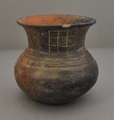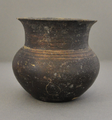VA·32
| Inscription | |
|---|---|
| Reading in transliteration: | ??? |
| Reading in original script: | |
|
| |
| Object: | VA·32 Golasecca (pitcher) |
| Position: | neck, outside |
| Orientation: | 0° |
| Direction of writing: | ambiguous |
| Script: | none |
| Number of letters: | 3 |
| Number of lines: | 1 |
| Workmanship: | scratched after firing |
| Condition: | complete |
|
| |
| Archaeological culture: | Golasecca II B [from object] |
| Date of inscription: | late 6th–early 5th c. BC [from object] |
|
| |
| Type: | unknown |
| Language: | none |
| Meaning: | unknown |
|
| |
| Alternative sigla: | Solinas 1995: 114 Morandi 2004: 75 |
|
| |
| Sources: | Morandi 2004: 571 no. 75 |
Images
|
| ||||
Commentary
First published in Castelfranco 1876: 99. Examined for LexLep on 27th April 2022.
Image in Castelfranco 1876: tav. III, no. 28 (drawing).
Three characters inscribed on the neck of the little pitcher, 4 cm to the left of the handle. The rightmost and middle character look like Lepontic St. Andrew's cross and (wonky inverted) upsilon, the leftmost character is not Lepontic, but Camunic ![]() . The sequence is unlikely to be a language-encoding Lepontic inscription. Indeed, it's first mention by Castelfranco can hardly be called a publication, insofar as the author produces it – together with a symbol on another object (Tav. III, no. 27 = Coll. Castelfranco 216 = A 0.9.28482) – as an example for "segnature" on Golaseccan objects which he does not consider to be alphabetic despite their occasional resemblance to Etruscan letters (cf. VA·5 on the Giani-Biondelli discussion). De Marinis 1986b: 76, n. 55, mentions the inscription, again in conjunction with VA·5, as one of two in the Castelfranco Collection at the Museo Archeologico di Milano, transliterating the present one (inverted?) as χlt, the other (Coll. Castelfranco 218 = A 0.9.28481) as pχ, but judging both to be "sigle più che di nomi". VA·32 is listed among archaic Lepontic inscriptions on vessels by Gambari & Colonna 1988: 160, no. 1; the authors consider it to be inverted and read sinistroverse
. The sequence is unlikely to be a language-encoding Lepontic inscription. Indeed, it's first mention by Castelfranco can hardly be called a publication, insofar as the author produces it – together with a symbol on another object (Tav. III, no. 27 = Coll. Castelfranco 216 = A 0.9.28482) – as an example for "segnature" on Golaseccan objects which he does not consider to be alphabetic despite their occasional resemblance to Etruscan letters (cf. VA·5 on the Giani-Biondelli discussion). De Marinis 1986b: 76, n. 55, mentions the inscription, again in conjunction with VA·5, as one of two in the Castelfranco Collection at the Museo Archeologico di Milano, transliterating the present one (inverted?) as χlt, the other (Coll. Castelfranco 218 = A 0.9.28481) as pχ, but judging both to be "sigle più che di nomi". VA·32 is listed among archaic Lepontic inscriptions on vessels by Gambari & Colonna 1988: 160, no. 1; the authors consider it to be inverted and read sinistroverse ![]()
![]()
![]() χut and compare CO·1 kut. Solinas 1995 includes the inscription with a reading ut, disregarding the atypical putative chi; Morandi again gives χut.
χut and compare CO·1 kut. Solinas 1995 includes the inscription with a reading ut, disregarding the atypical putative chi; Morandi again gives χut.
As said by Castelfranco and De Marinis, the marks are highly unlikely to be script. Among the eight small vessels which bear marks usually on the neck excavated by Castelfranco at the Golasecca necropolis which are kept in the Civico Museo Archeologico (Milano) (see the object page), the present one and Coll. Castelfranco 218 with ![]()
![]() on the neck (also mentioned by De Marinis) feature the most letter-like characters; the others have various complex single marks which are certainly not letters (see the photos above). Cf. also VA·5 and the other Giani finds from Golasecca. Where an orientation is recognisable, the characters are not inverted in relation to the vessel, so a reading of the left-hand side character as chi
on the neck (also mentioned by De Marinis) feature the most letter-like characters; the others have various complex single marks which are certainly not letters (see the photos above). Cf. also VA·5 and the other Giani finds from Golasecca. Where an orientation is recognisable, the characters are not inverted in relation to the vessel, so a reading of the left-hand side character as chi ![]() , even with short arms, is not possible in any case. Though examples for language-encoding inscriptions on similar beakers exists in NO·1 and the difficult-to-read VA·4.1/VA·4.2, the present marks are better classified as non-script marks or possibly pseudo-script.
, even with short arms, is not possible in any case. Though examples for language-encoding inscriptions on similar beakers exists in NO·1 and the difficult-to-read VA·4.1/VA·4.2, the present marks are better classified as non-script marks or possibly pseudo-script.
See also Salomon 2024b: 31–36.
Bibliography
| Castelfranco 1876 | Pompeo Castelfranco, "Due periodi della 1a Età del Ferro nella Necropoli di Golasecca", Bullettino di Paletnologia Italiana 2,1 (1876), 87–106. |
|---|---|
| De Marinis 1986b | Raffaele De Marinis, "I commerci dell'Etruria con i paesi a nord del Po dal IX al VI secolo a.C.", in: Raffaele De Marinis (ed.), Gli Etruschi a nord del Po. Mantova Palazzo Ducale - Galleria dell'Estivale, 21 settembre - 12 gennaio 1987, Mantova: 1986–1987. (catalogo della mostra, 2 volumes: vol. I 1986, vol. II 1987), I 52–80. |







